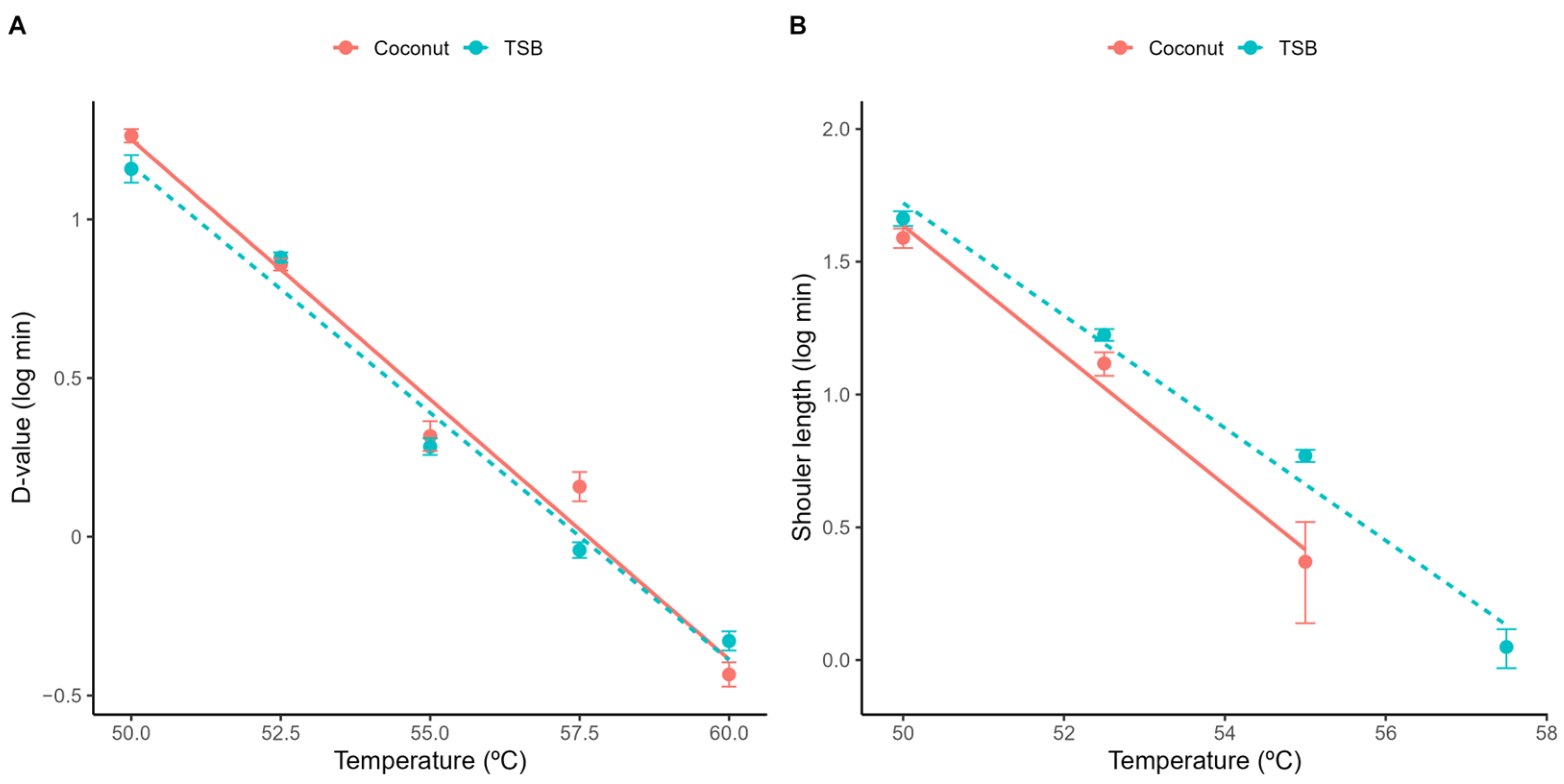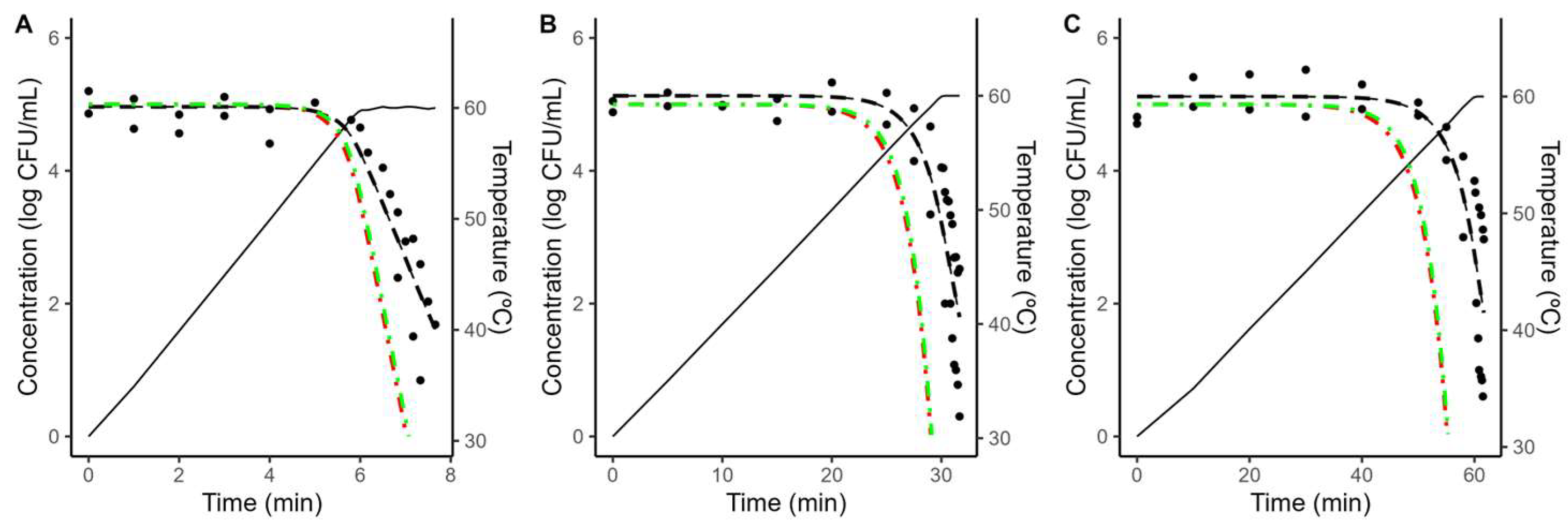Dynamic Thermal Treatments in Green Coconut Water Induce Dynamic Stress Adaptation of Listeria innocua That Increases Its Thermal Resistance
Abstract
:1. Introduction
2. Materials and Methods
2.1. Substrate
2.2. Microorganism and Preparation
2.3. Microbial Inactivation Experiments
2.4. Microbial Inactivation under Isothermal Conditions
2.5. Microbial Inactivation under Dynamic Heating Conditions
3. Results and Discussion
3.1. Inactivation of Listeria innocua in TSB and Coconut Water under Isothermal Conditions
3.2. Inactivation of Listeria innocua in TSB and Coconut Water under Dynamic Conditions
4. Conclusions
Author Contributions
Funding
Data Availability Statement
Conflicts of Interest
References
- Sriram, K.P.; Mangrolia, U.; Osborne, W.J. Isolation and characterization of culturable indigenous endophytic bacteria in the tender coconut. Food Biotechnol. 2020, 34, 228–242. [Google Scholar] [CrossRef]
- Tan, T.C.; Cheng, L.H.; Bhat, R.; Rusul, G.; Easa, A.M. Composition, physicochemical properties and thermal inactivation kinetics of polyphenol oxidase and peroxidase from coconut (Cocos nucifera) water obtained from immature, mature and overly-mature coconut. Food Chem. 2014, 142, 121–128. [Google Scholar] [CrossRef] [PubMed]
- Tuyekar, S.N.; Tawade, B.S.; Singh, K.S.; Wagh, V.S.; Vidhate, P.K.; Yevale, R.P.; Gaikwad, S.; Kale, M. An overview on coconut water: As a multipurpose nutrition. Int. J. Pharm. Sci. Rev. Res. 2021, 68, 63–70. [Google Scholar] [CrossRef]
- Yong, J.W.H.; Ge, L.; Ng, Y.F.; Tan, S.N. The chemical composition and biological properties of coconut (Cocos Nucifera L.) water. Molecules 2009, 14, 5144–5164. [Google Scholar] [CrossRef]
- Mordor Intelligence. Coconut Water Market Size and Share Analysis—Growth Trends and Forecasts (2023–2028); Mordor Intelligence: Hyderabad, India, 2023. [Google Scholar]
- Manna, K.; Khan, A.; Das, D.K.; Bandhu Kesh, S.; Das, U.; Ghosh, S.; Sharma Dey, R.; Das Saha, K.; Chakraborty, A.; Chattopadhyay, S.; et al. Protective effect of coconut water concentrate and its active component shikimic acid against hydroperoxide mediated oxidative stress through suppression of NF-κB and activation of Nrf2 pathway. J. Ethnopharmacol. 2014, 155, 132–146. [Google Scholar] [CrossRef] [PubMed]
- Bhagya, D.; Prema, L.; Rajamohan, T. Therapeutic effects of tender coconut water on oxidative stress in fructose fed insulin resistant hypertensive rats. Asian Pac. J. Trop. Med. 2012, 5, 270–276. [Google Scholar] [CrossRef] [PubMed]
- Rao, S.S.; Najam, R. Coconut water of different maturity stages ameliorates inflamatory processes in model of inflammation. J. Intercult. Ethnopharmacol. 2016, 5, 244–249. [Google Scholar] [CrossRef] [PubMed]
- Zulaikhah, S.T. Health benefits of tender coconut water (Tcw). Int. J. Pharm. Sci. Res. 2019, 10, 474–480. [Google Scholar]
- DebMandal, M.; Mandal, S. Coconut (Cocos nucifera L.: Arecaceae): In health promotion and disease prevention. Asian Pac. J. Trop. Med. 2011, 4, 241–247. [Google Scholar] [CrossRef]
- Anurag, P.; Rajamohan, T. Cardioprotective effect of tender coconut water in experimental myocardial infarction. Plant Foods Hum. Nutr. 2003, 58, 1–12. [Google Scholar] [CrossRef]
- Campbell-Falck, D.; Thomas, T.; Falck, T.M.; Tutuo, N.; Clem, K. The intravenous use of coconut water. Am. J. Emerg. Med. 2000, 18, 108–111. [Google Scholar] [CrossRef] [PubMed]
- Naik, M.; Sunil, C.K.; Rawson, A.; Venkatachalapathy, N. Tender coconut water: A review on recent advances in processing and preservation. Food Rev. Int. 2022, 38, 1215–1236. [Google Scholar] [CrossRef]
- Walter, E.H.M.; Kabuki, D.Y.; Esper, L.M.R.; Sant’Ana, A.S.; Kuaye, A.Y. Modelling the growth of Listeria monocytogenes in fresh green coconut (Cocos nucifera L.) water. Food Microbiol. 2009, 26, 653–657. [Google Scholar] [CrossRef] [PubMed]
- Basak, S.; Jha, T.; Chakraborty, S. Pasteurization of tender coconut water by pulsed light treatment: Microbial safety, enzymatic inactivation, and impact on physicochemical properties. Innov. Food Sci. Emerg. Technol. 2023, 84, 103302. [Google Scholar] [CrossRef]
- Maguluri, R.K.; Nettam, P.; Chaudhari, S.R.; Yannam, S.K. Evaluation of UV-C LEDs efficacy for microbial inactivation in tender coconut water. J. Food Process. Preserv. 2021, 45, e15727. [Google Scholar] [CrossRef]
- Mahnot, N.K.; Mahanta, C.L.; Keener, K.M.; Misra, N.N. Strategy to achieve a 5-log Salmonella inactivation in tender coconut water using high voltage atmospheric cold plasma (HVACP). Food Chem. 2019, 284, 303–311. [Google Scholar] [CrossRef]
- Georgalis, L.; Yeak, K.Y.C.; Tsimpou, C.; Fernandez, P.S.; Wells-Bennik, M.; Garre, A. Disentangling the contributions of initial heterogeneities and dynamic stress adaptation to nonlinearities in bacterial survival curves. Food Res. Int. 2023, 173, 113385. [Google Scholar] [CrossRef]
- Dolan, K.D.; Valdramidis, V.P.; Mishra, D.K. Parameter estimation for dynamic microbial inactivation: Which model, which precision? Food Control 2013, 29, 401–408. [Google Scholar] [CrossRef]
- Hassani, M.; Cebrián, G.; Mañas, P.; Condón, S.; Pagán, R. Induced thermotolerance under nonisothermal treatments of a heat sensitive and a resistant strain of Staphylococcus aureus in media of different pH. Lett. Appl. Microbiol. 2006, 43, 619–624. [Google Scholar] [CrossRef]
- Garre, A.; Huertas, J.P.; González-Tejedor, G.A.; Fernández, P.S.; Egea, J.A.; Palop, A.; Esnoz, A. Mathematical quantification of the induced stress resistance of microbial populations during non-isothermal stresses. Int. J. Food Microbiol. 2018, 266, 133–141. [Google Scholar] [CrossRef]
- Fairchild, T.M.; Foegeding, P.M. A proposed nonpathogenic biological indicator for thermal inactivation of Listeria monocytogenes. Appl. Environ. Microbiol. 1993, 59, 1247–1250. [Google Scholar] [CrossRef] [PubMed]
- Silva-Angulo, A.B.; Zanini, S.F.; Rodrigo, D.; Rosenthal, A.; Martinez, A. Growth kinetics of Listeria innocua and Listeria monocytogenes under exposure to carvacrol and the occurrence of sublethal damage. Food Control 2014, 37, 336–342. [Google Scholar] [CrossRef]
- Saucedo-Reyes, D.; Marco-Celdrán, A.; Pina-Pérez, M.C.; Rodrigo, D.; Martínez-López, A. Modeling survival of high hydrostatic pressure treated stationary- and exponential-phase Listeria innocua cells. Innov. Food Sci. Emerg. Technol. 2009, 10, 135–141. [Google Scholar] [CrossRef]
- Conesa, R.; Andreu, S.; Fernández, P.S.; Esnoz, A.; Palop, A. Nonisothermal heat resistance determinations with the thermoresistometer Mastia. J. Appl. Microbiol. 2009, 107, 506–513. [Google Scholar] [CrossRef] [PubMed]
- Geeraerd, A.H.; Herremans, C.H.; Van Impe, J.F. Structural model requirements to describe microbial inactivation during a mild heat treatment. Int. J. Food Microbiol. 2000, 59, 185–209. [Google Scholar] [CrossRef]
- Peñalver-Soto, J.L.; Garre, A.; Esnoz, A.; Fernández, P.S.; Egea, J.A. Guidelines for the design of (optimal) isothermal inactivation experiments. Food Res. Int. 2019, 126, 108714. [Google Scholar] [CrossRef]
- Garre, A.; Fernández, P.S.; Lindqvist, R.; Egea, J.A. Bioinactivation: Software for modelling dynamic microbial inactivation. Food Res. Int. 2017, 93, 66–74. [Google Scholar] [CrossRef]
- Garre, A.; Clemente-Carazo, M.; Fernández, P.S.; Lindqvist, R.; Egea, J.A. Bioinactivation FE: A free web application for modelling isothermal and dynamic microbial inactivation. Food Res. Int. 2018, 112, 353–360. [Google Scholar] [CrossRef]
- Fernández, A.; Ocio, M.J.; Fernández, P.S.; Rodrigo, M.; Martinez, A. Application of nonlinear regression analysis to the estimation of kinetic parameters for two enterotoxigenic strains of Bacillus cereus spores. Food Microbiol. 1999, 16, 607–613. [Google Scholar] [CrossRef]
- R Core Team. A Language and Environment for Statistical Computing; R Foundation for Statistical Computing: Vienna, Austria, 2022. [Google Scholar]
- Moré, J.J. The Levenberg-Marquardt algorithm: Implementation and theory. In Numerical Analysis; Springer: Berlin/Heidelberg, Germany, 1978; pp. 105–116. [Google Scholar] [CrossRef]
- Elzhov, T.V.; Mullen, K.M.; Spiess, A.-N.; Bolker, B. minpack.lm: R interface to the Levenberg-Marquardt Nonlinear Least-Squares Algorithm Found in MINPACK, Plus Support for Bounds. 2016. Available online: https://cran.r-project.org/web/packages/minpack.lm/minpack.lm.pdf (accessed on 4 August 2023).
- Baranyi, J.; Roberts, T.A.; McClure, P. A non-autonomous differential equation to model bacterial growth. Food Microbiol. 1993, 10, 43–59. [Google Scholar] [CrossRef]
- Ruiz, V.; Alonso, R.; Salvador, M.; Condón, S.; Condón-Abanto, S. Impact of shoulders on the calculus of heat sterilization treatments with different bacterial spores. Food Microbiol. 2021, 94, 103663. [Google Scholar] [CrossRef] [PubMed]
- Álvarez-Ordóñez, A.; Fernández, A.; López, M.; Bernardo, A. Relationship between membrane fatty acid composition and heat resistance of acid and cold stressed Salmonella Senftenberg CECT 4384. Food Microbiol. 2009, 26, 347–353. [Google Scholar] [CrossRef] [PubMed]
- Álvarez-Ordóñez, A.; Fernández, A.; López, M.; Arenas, R.; Bernardo, A. Modifications in membrane fatty acid composition of Salmonella Typhimurium in response to growth conditions and their effect on heat resistance. Int. J. Food Microbiol. 2008, 123, 212–219. [Google Scholar] [CrossRef] [PubMed]
- Garre, A.; Egea, J.A.; Iguaz, A.; Palop, A.; Fernandez, P.S. Relevance of the induced stress resistance when identifying the critical microorganism for microbial risk assessment. Front. Microbiol. 2018, 9, 1663. [Google Scholar] [CrossRef] [PubMed]
- Stasiewicz, M.J.; Marks, B.P.; Orta-Ramirez, A.; Smith, D.M. Modeling the effect of prior sublethal thermal history on the thermal inactivation rate of Salmonella in ground Turkey. J. Food Prot. 2008, 71, 279–285. [Google Scholar] [CrossRef]
- Huertas, J.P.; Ros-Chumillas, M.; Garre, A.; Fernández, P.S.; Aznar, A.; Iguaz, A.; Esnoz, A.; Palop, A. Impact of heating rates on Alicyclobacillus acidoterrestris heat resistance under non-isothermal treatments and use of mathematical modelling to optimize orange juice processing. Foods 2021, 10, 1496. [Google Scholar] [CrossRef]
- Janssen, M.; Verhulst, A.; Valdramidis, V.; Devlieghere, F.; Van Impe, J.F.; Geeraerd, A.H. Inactivation model equations and their associated parameter values obtained under static acid stress conditions cannot be used directly for predicting inactivation under dynamic conditions. Int. J. Food Microbiol. 2008, 128, 136–145. [Google Scholar] [CrossRef]
- Garre, A.; González-Tejedor, G.A.; Aznar, A.; Fernández, P.S.; Egea, J.A. Mathematical modelling of the stress resistance induced in Listeria monocytogenes during dynamic, mild heat treatments. Food Microbiol. 2019, 84, 103238. [Google Scholar] [CrossRef]
- Valdramidis, V.P.; Geeraerd, A.H.; Van Impe, J.F. Stress-adaptive responses by heat under the microscope of predictive microbiology. J. Appl. Microbiol. 2007, 103, 1922–1930. [Google Scholar] [CrossRef]
- Clemente-Carazo, M.; Cebrián, G.; Garre, A.; Palop, A. Variability in the heat resistance of Listeria monocytogenes under dynamic conditions can be more relevant than that evidenced by isothermal treatments. Food Res. Int. 2020, 137, 109538. [Google Scholar] [CrossRef]





| Parameter | Acidified TSB | Coconut Water |
|---|---|---|
| log N0 (log CFU/mL) | 5.34 ± 0.11 | 5.30 ± 0.23 |
| a (min) | 0.58 ± 0.07 | 0.12 ± 0.31 |
| b (min/°C) | 0.20 ± 0.01 | 0.23 ± 0.05 |
| log D55 (log min) | 0.46 ± 0.03 | 0.46 ± 0.04 |
| z (°C) | 4.94 ± 0.25 | 5.00 ± 0.24 |
| Medium | Heating Rate (°C/Min) | D55 (Min) |
|---|---|---|
| Acidified TSB | 0.5 | 17.99 ± 1.17 |
| 1 | 10.44 ± 0.07 | |
| 5 | 5.66 ± 0.23 | |
| Coconut water | 0.5 | 18.77 ± 2.15 |
| 1 | 11.64 ± 1.10 | |
| 5 | 6.23 ± 2.04 |
Disclaimer/Publisher’s Note: The statements, opinions and data contained in all publications are solely those of the individual author(s) and contributor(s) and not of MDPI and/or the editor(s). MDPI and/or the editor(s) disclaim responsibility for any injury to people or property resulting from any ideas, methods, instructions or products referred to in the content. |
© 2023 by the authors. Licensee MDPI, Basel, Switzerland. This article is an open access article distributed under the terms and conditions of the Creative Commons Attribution (CC BY) license (https://creativecommons.org/licenses/by/4.0/).
Share and Cite
González-Tejedor, G.A.; Garre, A.; Iguaz, A.; Wong-Zhang, R.; Fernández, P.S.; Possas, A. Dynamic Thermal Treatments in Green Coconut Water Induce Dynamic Stress Adaptation of Listeria innocua That Increases Its Thermal Resistance. Foods 2023, 12, 4015. https://doi.org/10.3390/foods12214015
González-Tejedor GA, Garre A, Iguaz A, Wong-Zhang R, Fernández PS, Possas A. Dynamic Thermal Treatments in Green Coconut Water Induce Dynamic Stress Adaptation of Listeria innocua That Increases Its Thermal Resistance. Foods. 2023; 12(21):4015. https://doi.org/10.3390/foods12214015
Chicago/Turabian StyleGonzález-Tejedor, Gerardo A., Alberto Garre, Asunción Iguaz, Ricardo Wong-Zhang, Pablo S. Fernández, and Arícia Possas. 2023. "Dynamic Thermal Treatments in Green Coconut Water Induce Dynamic Stress Adaptation of Listeria innocua That Increases Its Thermal Resistance" Foods 12, no. 21: 4015. https://doi.org/10.3390/foods12214015
APA StyleGonzález-Tejedor, G. A., Garre, A., Iguaz, A., Wong-Zhang, R., Fernández, P. S., & Possas, A. (2023). Dynamic Thermal Treatments in Green Coconut Water Induce Dynamic Stress Adaptation of Listeria innocua That Increases Its Thermal Resistance. Foods, 12(21), 4015. https://doi.org/10.3390/foods12214015









